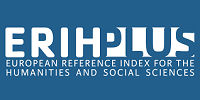Culture and identity put to the test by displacement –For a topographical reading of displacement in Tahar Ben Jelloun’s 'Partir'–
DOI:
https://doi.org/10.7203/HYBRIDA.4.23975Keywords:
Tahar Ben Jelloun, displacement, lexical approach, identity, culture Abstract
Abstract
This article aims to study the expression of displacement from a typological perspective and to examine the scope of typology on the semantic and lexical enunciation of spatial information. Tahar Ben Jelloun’s novel Partir is concerned, among other things, with displacement, a topos with true priority in the diegetic universe. This spatialization of the meaning of the world leads to dissecting the captivity of the diegesis in a given space and, therefore, the reproblematization of identity factors caused by displacement. Immigration is both for the writer and his protagonists, a fatality, and an existential choice, evoking both the movement of the self in space and the movement of space in the self. Immigrants change their name, language, culture, and identity. This identity malaise reveals the two facets of wandering, namely the geographical pilgrimages and the wanderings of the spirit in search of the European El Dorado.
 Downloads
Downloads
 References
References
Araya, V. B. (2013). Le labyrinthe arabo-musulman dans les romans de Tahar Ben Jelloun. Letras, (54), 71-90. https://doi.org/10.15359/rl.2-54.4
Aurnague, M. (2008). Qu’est-ce qu’un verbe de déplacement ? : critères spatiaux pour une classification des verbes de déplacement intransitifs du français. In J. Durand, B. Habert (dir.), Congrès Mondial de Linguistique Française – CMLF08 (pp. 1905-1917). https://doi.org/10.1051/cmlf08041
Bhabha, H. K. (2007). Les lieux de la culture: une théorie postcoloniale. Traduit par Françoise Bouillot. Payot et Rivages.
Bal, M. (2002). Travelling Concepts in the Humanities : A Rough Guide. University of Toronto Press.
Ben Jelloun, T. (15 février 1976). Dossier consacré aux évadés de l’empire. Les Nouvelles Littéraires, 14–17.
Ben Jelloun, T. (2007). On ne parle pas le francophone. Le Monde diplomatique, (638), 20–21.
Boons, J.-P. (1985). Préliminaires à la classification des verbes locatifs : les compléments de lieu, leurs critères, leurs valeurs aspectuelles. Lingvisticæ Investigationes, 9(2), 195-267. https://doi.org/10.1075/li.9.2.02boo
Borillo, A. (1998). L’espace et son expression en français. Ophrys.
Bouvet, R. (2006). Pages de sable. Essai sur l’imaginaire du désert. XYZ Éditeur.
Christiane, A. (2005). L’immigration dans le roman francophone contemporain. Karthala.
Defarges, P. M. (1994). Introduction à la géopolitique. Seuil.
Forestal, C. (2008). L’approche transculturelle en didactique des langues-cultures : une démarche discutable ou qui mérite d’être discutée ? Éla. Études de linguistique appliquée, (152), 393-410. https://doi.org/10.3917/ela.152.0393
Gauvin, L. (1997). La surconscience linguistique de l’écrivain francophone. In L. Gauvin (Dir.), L’Écrivain francophone à la croisée des langues (pp. 5-15). Karthala.
Gauvin L. (2004). La fabrique de la langue, de Françoise Rabelais à Régent Ducharme. Seuil.
Jabès, E. (1978). Le Soupçon, Le désert. Gallimard.
Kopecka, A. (2009). L’expression du déplacement en français : l’interaction des facteurs sémantiques, aspectuels et pragmatiques dans la construction du sens spatial. Langages, (173), 54-73. https://doi.org/10.3917/lang.173.0054
Kupferman, L. (2008). Les verbes de déplacement et le rôle Source. Langages, (169), 92-110. https://doi.org/10.3917/lang.169.0092
Landowski, E. (1997). Présences de l’autre. Essais de socio-sémiotique II. Presses universitaires de France.
Laur, D. (1989). Sémantique du déplacement à travers une étude de verbes et de prépositions en français. Cahiers de grammaire, (14), 67-83.
Laur, D. (1993). La relation entre le verbe et la préposition dans la sémantique du déplacement. Langages, (110), 47-67. https://doi.org/10.3406/lgge.1993.1098
Levinson, S. C. (2003). Space in Language and Cognition. Explorations in Linguistic Diversity. Cambridge University Press.
Lindenlauf, N. (1996). Tahar Ben Jelloun: Les Yeux baissés. Labor.
Memmi, A. (1985). Portrait du colonisé / Portrait du colonisateur. Gallimard.
Noiray, J. (1996). Littératures francophones. I. Le Maghreb. Belin.
Pageaux, D-H. (2000). De la géocritique à la géosymbolique. Regards sur un champ interdisciplinaire : littérature générale et comparée et géographie. In B. Westphal (Dir.), La géocritique mode d’emploi (pp. 125-160). Pulim.
Raqbi, A. (2005). Le Moi masqué de Tahar Ben Jelloun. Dalhousie French Studies, Halifax, 70, 21–28.
Romey, G. (1995). Dictionnaire de la symbolique. Le vocabulaire fondamental des rêves. Albin Michel.
Thibeault, J. (2015). Des identités mouvantes. Se définir dans le contexte de la mondialisation. Nota bene.
Topia, A. (1996). Contrepoints joyciens. Poétique, (27), 351-371.
Tuan, Y.-F. (2006). Espace et lieu. La perspective de l’expérience. Folio.
Vandeloise, C. (1986). L’espace en français : sémantiques des prépositions spatiales. Seuil.
Downloads
Published
How to Cite
-
Abstract557
-
PDF (Français )415
Issue
Section
License
![]()
All the documents in the OJS platform are open access and property of their respective authors.
Authors publishing in the journal agree to the following terms:
- Authors keep the rights and guarantee HYBRIDA the right to be the first publication of the document, licensed under a Creative Commons license Attribution-NonCommercial-ShareAlike 4.0 International (CC BY-NC-SA 4.0) that allows others to share the work with an acknowledgement of authorship and publication in the journal.
- Authors are allowed and encouraged to spread their work (once published) through electronic means using personal or institutional websites (institutional open archives, personal websites or professional and academic networks profiles) once the text has been published.
















